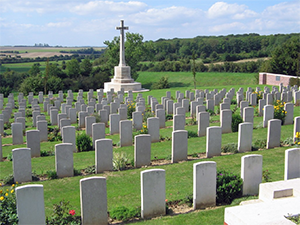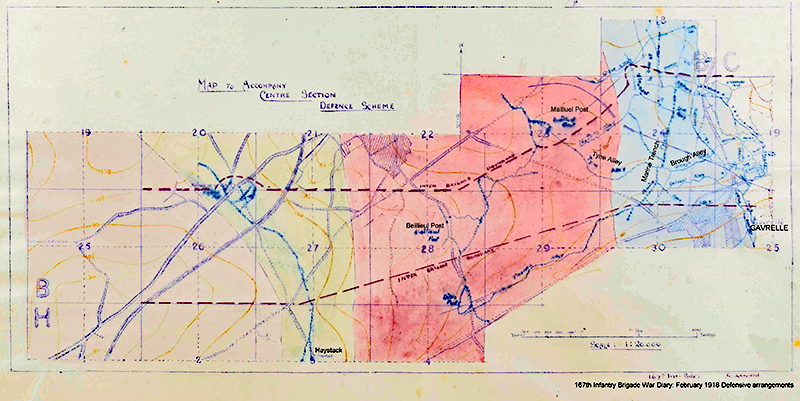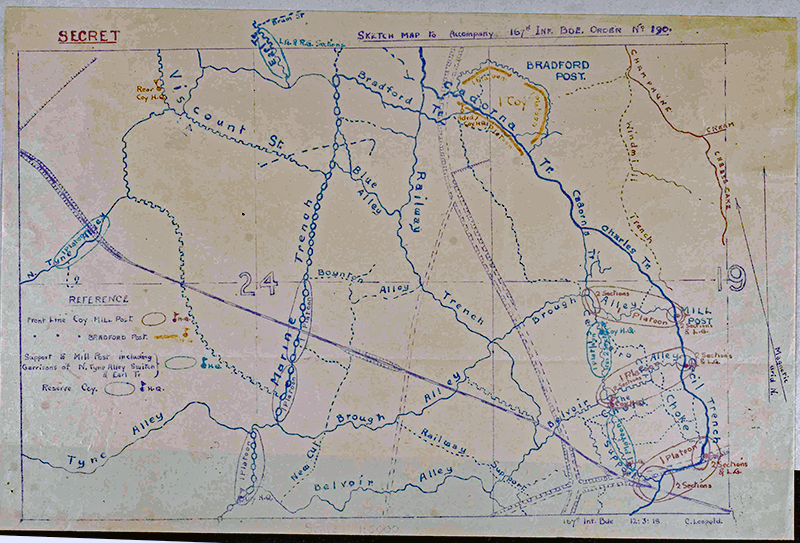First World War Project
Albert Edward PILES (of Newnham)
b. 1886 Private, Service Number G/41464 |

Albert Edward Piles was the fourth of nine children born to Alfred Piles and Harriet (née Baldock), who were married in Otterden, 1880. Alfred hardly moved from Otterden, as he spent most of his married life in Little Frith, Newnham, with a brief period in Wye Banks, Otterden, only one mile away. Albert's elder siblings were Alfred George, Minnie, and Frederick while his younger siblings were Dennis, Annie, Mabel, Lily and Fanny. Most were born at Little Frith Farm, but Albert was born at Wye Banks ("Whybanks"), Otterden.
Alfred Piles was the named beneficiary of Albert's estate that amounted to £37 (including £8 10s. War Gratuity). [See Appendix 2]
Military Experience of Albert Edward Piles
After attestation near to March 1916 (from his War Gratuity calculation), Albert's route through the Middlesex Regiments is revealed in is medal card as enlistment with (No. 3697) 6th (Service) East Kent Battalion ("The Buffs"), Private. Thereafter, Albert began in the 18th (1st Public Works Pioneers) Battalion, which served in France from 1915; then he moved to the 11th (Service) Battalion, which was the Middlesex Regiment's first Kitchener's Army unit; and finally 1/7th Middlesex Regiment in which he served at the time of his death.
On the face of it, this suggests that Albert moved into France (perhaps beginning of 1917) to join the 18th (Middlesex) Battalion, and was moved as needed thereafter.
During 1917, the 1/7th Middlesex pursued the German retreat to the Hindenburg Line (14th March to 5th April). He probably saw action in the First Battle of the Scarpe (9th - 14th April), the Third Battle of the Scarpe (3rd/4th May) and the Battle of Langemarck (16th/17th August). As the year drew to a close, the Battalion took part in the capture of Tadpole Copse (21st November) and the misjudged capture of Bourlon Wood (23rd/28th November). The final named engagement was the German counter attacks over Bourlon Wood from 30th November to 2nd December. There followed the winter lull before the opening of the German Spring Offensive - Albert died in the first wave of attacks on British positions.
Circumstances of the death of Albert Edward Piles
The German Spring Offensive was anticipated but without knowledge of the actual day nor the extent of the opening attack. The opening attack took place on the SOMME Front (See Charles Henry Back). In the event, that opening attack soon extended across the wider Front, at ARRAS, on 28th March 1918.
Albert was one of six Battalion deaths recorded for this action on the opening day of the First Battle of Arras, 1918.
The War Diary for the 1/7th Middlesex for March 1918 sets the scene:-
1st March: GAVRELLE: Battalion holding front line in Gavrelle Sector with B & D Companies in MILL POST and C Company in BRADFORD POST & A Company in support.
2nd to 4th March: Situation very quiet. Casualties: 1 O.R. killed.
4th March: Battalion relieved by 8th Middlesex Regiment, and on relief moved back into Reserve at WAKEFIELD CAMP.
5th to 7th March: WAKEFIELD CAMP: In Reserve. Usual company parades and inspections. Reconnaissance of GREEN LINE in case of sudden move. Draft of 50 O.R. arrived from Base & posted. 20 to C Company and 30 to D Company.
8th March: Moved up into Support and relieved 1st London Regiment. 2 Companies in Railway Cutting and 2 Companies in RED LINE.
9th to 13th March: Working Parties etc under Royal Engineers. Reconnaissance of BROWN LINE.
13th March: Battalion "stood to" in battle positions in BROWN LINE in view of an expected attack on our right. Situation was however normal.
14th March: GAVRELLE: Battalion relieved 1st London Regiment in front line. Dispositions – D Company in MILL POST with A Company in Support, C Company in BRADFORD POST and B Company in Battalion Reserve in Marine Trench.
15th to 20th March: Battalion holding front line. Patrols out nightly to ascertain whether suspected relief had taken place. No enemy patrols seen or heard and no unusual movement reported. On the night of 19th enemy Trench Mortars active on MILLS and BRADFORD POSTS in retaliation for raid by the Battalion on our right. No casualties.
21st March: MILL POST heavily bombarded at "stand to" and a smoke screen put down in front of it, but no infantry action followed. The left of the post was badly damaged but there were no casualties.
Battalion relieved in MARINE TRENCH and MILL POST by the "L.R.Bs" and in BRADFORD POST and N.TYNE ALLEY by the "KENSINGTONS". On relief, Battalion moved back to WAKEFIELD CAMP.
22nd March: WAKEFIELD CAMP: Battalion in Reserve. General cleaning up and usual Company parades.
23rd March: Battalion "stood to" at 5 a.m. ready to move forward to battle positions at an hour's notice. Ordered to "stand down" 7.30 a.m.
The whole Battalion out on working parties at night digging new trench from TOWN TRACK to RED LINE.
25th to 27th March: WAKEFIELD CAMP: Battalion "stood to" daily at 4.30 a.m. in view of the possibility of an enemy attack.
28th March: GAVRELLE SECTOR: The enemy attacked along the whole of the Divisional front at 7 a.m.
Battalion "stood to" at 5.30 a.m.
At 7 a.m. orders received to move forward to assembly positions. Companies moved forward immediately, and bombs & ammunition etc. drawn.
8.45 a.m. Orders received for Battalion to move into a position near CHANTECLER JUNCTION (Area B.25.b).
9.25 a.m. Battalion reported in new position.
11.10 a.m. warning that Battalion might come under orders of 169 Brigade. Lieut Hargraves & 3 runners sent to 169th Brigade Headquarters.
11.30 a.m. to 12 noon Trenches heavily shelled, and A Company had 4 killed and several wounded.
5 p.m. Commanding Officer & Company Commanders went forward and reconnoitred TONGUE POST and PONT DE JOUR, in view of possibility of a counter attack.
7 p.m. C.O. reported to Brigade H.Q.
9.55 p.m. Orders received for Battalion to move into RED LINE.
11 p.m. First Company moved off. Casualties during day – 6 O.R. killed and 14 wounded.
29th March: GAVRELLE SECTOR: 5.30 a.m. Relief in RED LINE Complete. Battalion boundary DITCH POST exclusive to MAILLEUL EAST POST exclusive. Casualties for day 8 O.R. wounded.


Albert Edward Piles was posthumously awarded the British War and Victory Medals. [See Appendix 1]
Family of Albert Edward Piles
Additional Documents
167th Infantry Brigade Resume to 56th Division
EXTRACT: 167th Infantry Brigade War Diary
Headquarter. 56th Division. E. 3/385
RESUME OF OPERATIONS OF MARCH 28/29/30, 1918
Reference Map 51B.N.W.
At 4 a.m. on the morning of the 28th, the alarm was given and the Brigade was ordered to Stand to Arms. At 5.55 a.m. orders were received for one Battalion of the Brigade to move from G.3.b.9.5. up to assembly positions behind MOUND POST at about G.6.a.00.90. The 8th Middlesex Regiment were accordingly ordered to move forward.
Brigade H.Q. moved up to H.1.d.05.75. where H.Qrs. were established at 7 a.m.
The 8th Middlesex Regiment reported in position at 7.5 a.m.
At 7.50 a.m. the 7th Middlesex Regiment was ordered by Division to move forward from WAKEFIELD CAMP to assembly positions at about A.30.c.50.00.
At 8.5 a.m. the 7th and 8th Middlesex Regiment were ordered to move forward into a position of readiness at B.25.b. and H.2.a. and c. respectively. The two Field Companies Royal Engineers were moved up to JUNCTION REDOUBT at 8.15 a.m.
At about 9 a.m. orders were issued by Brigade to the 167th Trench Mortar Battery to move forward to their assembly positions behind MOUND POST. At 10.25 a.m. orders were received from 56th Division placing 8th Middlesex Regiment at the disposal of the B.G.C. 169th Infantry Brigade. Shortly afterwards they were ordered up by 169th Infantry Brigade to occupy the POINT DU JOUR REDOUBT.
At 11.40 a.m. news was received that the 168th and 169th Infantry Brigades had been ordered to withdraw to the RED LINE.
The 167th T.M. Battery was ordered at 1.40 p.m. to place 4 guns in position in TONGUE POST and 2 guns to cover the Sunken Roads in B.27.b.
At 7.5 p.m. a warning order was received from Division that if the circumstances permitted the 169th Infantry Brigade would be relieved in the line by 167th Infantry Brigade. Orders were issued at 11.50 p.m. to all Battalions and the T.M. Battery.
Under orders issued direct by 56th Division the 5th Battalion C.M.I. took over the defences of POINT DU JOUR REDOUBT at 11.30 p.m. and were responsible for the defences of this locality.
A wire giving the dispositions of the Brigade was sent to 56th Division at 6.20 a.m. on the morning of the 29th.
The 12th Infantry Brigade (right flank Brigade) reported the S.O.S. at 9.10 a.m. but no infantry action took place on this Brigade front. At 11.47 a.m. the Division issued instructions to the effect that the FARBOS Line, within the Brigade boundaries, was to be occupied. This had already been done by the 1st London Regiment. Several reports were received during the morning from observers that the enemy was massing in our old front and support lines but no action followed in any case. Movement however during the whole day was very considerable in rear of the enemy's old front line.
At 2 p.m. orders were received from Division giving details of inter-Divisional relief on the conditions that the tactical situation was favourable. At 6.18 p.m. these orders were confirmed. The Commanding Officers of Battalions in the Brigade were personally informed of the relief and all arrangements were made.
These verbal orders were confirmed by 167th Infantry Brigade O.O. No.196 issued at 9.20 p.m. The relief was reported complete by 5.30 a.m. on the morning of the 30th and the Brigade moved back to the VILLERS-AU-BOIS area during the day.
EXPERIENCES GAINED.
It is essential that troops in assembly areas should dig themselves in.
Buried cable to O.P.'s essential.
Sufficient Field Guns are required to engage targets of opportunity.
Brigadier-General, Commanding 167th Infantry Brigade.
Date 3rd April 1918


 World War 1 Pages
World War 1 Pages